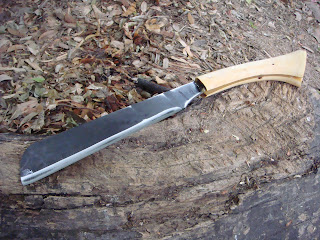In the preceding article “Brushland Machetes” I posted the following photo of an Ontario Knife Company small machete I’ve owned for nearly twenty-five years. Over the decades this small machete has seen hard use but not in the traditional sense of whacking trails through the woods or fashioning implements at faraway camps. Instead, I’d relegated the blade to a tackle box where it saw action cutting off stingray tails and barbs and other related saltwater fishing chores. That environment is hard on carbon steel so when I finally took it out of service it needed reconditioning for use in the wilds.
Even after re-contouring the blade tip and cutting off a nasty finger-guard that compresses the little finger during chopping thus creating a good deal of pain, I still was not enamored with the tool. The plastic grip was too large. Large grips can be dangerous in machetes because they do not allow the hand to properly grip the handle. This is amplified with plastic grips that become slippery when doused with sweat. In addition the handle jutted out straight backwards from the blade and that strained the wrist when whacking brush. Straight grips become more of a problem with shorter blades than with longer blades because of the smaller arc associated with working a short blade when compared to a long blade. In other words, the longer the blade (within reason) the greater the arc at the tip than near the handle which increases momentum and therefore reduces the amount of energy needed to successfully slice through objects like brush or bamboo.
The Malaysian parang and its cousins in southeast Asia tend to be shorter in length than the machetes used from the Rio Grande south to the Amazon. In order to compensate for the shorter blade length most parangs have an angled (usually downward) handle that adjusts for the shorter arc created in chopping. Some people argue that the parang is not a machete but this is perhaps a debate based more in semantics than logic. Whether they’re called machetes, parangs, goloks, pangas or other names, these blades fulfill an identical task of chopping through light brush whether herbaceous shrubs, bamboo or hardwood saplings.
Anyway, I removed the bulky plastic grip and reshaped the tang as shown below. You’ll notice that the altered tang now has a modest down-sweep.
With the reshaping accomplished I then took a curving section from a chaparro prieto branch (Acacia rigidula) and split it into two parts. I sanded the inner splits smooth then calculated how I wanted the tang to fit into the handle. I took note of the natural slope of the wood and augmented that by placing the tang slightly upward from the slope so that the finished handle would have a distinctive downward curve.
In years past I’ve played around with a couple of parangs “liberated” from distant battle fields in two different wars by a couple of fellows I knew. I liked the ergonomic simplicity of the design and always wanted to duplicate that in a machete. The Ontario Knife Company “military” machete is built for heavy duty and the blade is a bit thicker—measuring 3.0 millimeters with my ruler—than most conventional machetes. Even so, the typical parang is a bit thicker going from 3.0 to 5.0 millimeters or even slightly more. I’m in the process of completing a couple of parangs that will measure nearly one-quarter inch blade thickness but I’m worried they may be a bit too heavy for everyday use. I’ll also finish a handle on a rejuvenated old, thin-bladed machete that will incorporate the ergonomics of a parang.
Here’s the finished Ontario Knife Co. small machete now turned parang. Note the brass pins I used to secure the two halves together. Most conventional parangs use a flimsy stick tang that is inserted into a hole drilled into a piece of wood. Sometimes the stick tang is pinned but often it is simply held in place by tension or glue. In one of the parangs I handled the blade had worked loose and could simply be slipped out without much effort. The parang was kept on a shelf in the living room as perhaps a remembrance of hardships and lost friends and so the fact that the handle was loose didn’t make much difference.
The above photo gives you a good look at the sloping handle. The difference in “feel” between the new wooden handle and the old plastic handle is significant. The new handle makes me want to carry this blade instead of sticking it in a tackle box.
The chaparro prieto wood handle is mostly white-wood with a rod of reddish heartwood streaming down the center. You can see the heartwood in this photo. This acacia species is very dense with a specific gravity measuring in the low 0.80 range and must be thoroughly dried before using it. This wood was not completely dried and I had a hard time stabilizing it. I’m keeping an eye on it.
I used an epoxy amalgam with guayacan wood (Guaiacum angustifolium) dust mixed into the epoxy. This creates an extremely hard and strong bonding. This week I plan to finish the old-machete rejuvenation and I’ll post photos of that project when completed.
Parang Dimensions:
Overall length: 16 5/8 inches
Blade length: 10 inches
Handle length: 6 5/8 inches






Fantastic idea. Im quiet keen to attemp this myself using a cheap machete as a survival blade. Any advice or scetches would be appreciated. Im quiet good with my hands but have only basic tools. Many thanks.
ReplyDeleteAndrew. 117esso@gmail.com
Great Article. Thanks for this.
ReplyDelete